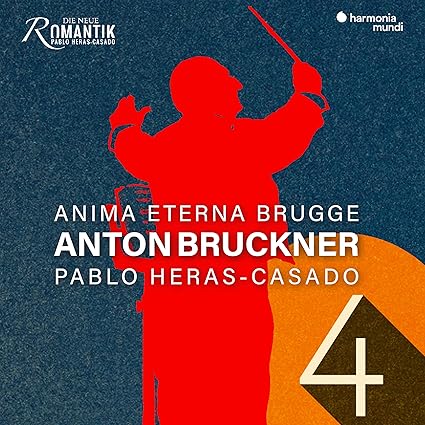

In all of music, is there anything more lofty, more evocative, than the few opening bars of the Symphony No. 4 in E-flat major "Romantic" by Anton Bruckner (1824-1896). It only takes 8 notes at the very beginning of the first movement to set the tone of the whole symphony. The first set of four, a descending open fifth than inverted into an ascending open fifth. This is repeated but the second time the first note of the group is raised by a half-tone. This simple gesture lends everything a lift, an epic resplendence usually only heard within Gustav Mahler's music. Add to this the choice of orchestration - a solo horn set against a backdrop of extremely soft shimmering strings - and you have the recipe for a spine-tingling effect. And on this new recording featuring the period instrument orchestra Anima Eterna Brugge, the circa 1875 horn played so eloquently by Pierre-Antoine Tremblay projects the perfect sonic effect required to convey this vivid imagery.
And it doesn't end there. This orchestra may be slightly smaller in size than some of the big boys, but it still delivers an energetic sonic punch when called for. The ending of the first movement, with its full set of horns bellowing the same opening four notes set against the full orchestra, more than produces the desired impact but with an added clarity of detail rarely heard.
Some critics thumb their noses at the mere mention of recordings featuring period instrument orchestras, when in fact I find that they generate a more authentic, shall we say less photoshoped sound than their modern counterparts. If this is the sound Bruckner was familiar with and had in mind when orchestrating his music, than what could be more adequate. A case in point is another great recent recording of Mahler's 9th with the Mahler Academy Orchestra. There's an added textural clarity combined with a somewhat less pitch-perfect timbral instrument sound which lends everything a more natural outcome.
Spanish conductor Pablo Heras-Casado, whose already impressive discography affirms, leads a fresh approach to the music of Bruckner. Flowing tempos carry the slow movement forward whilst rapid yet precise, and highly articulate gestures mark this work's famous Scherzo movement, and a fiery disposition marks the last with as uplifting a final minute I've ever heard. This makes for a vibrant and exciting listening experience when compared to conductors of the past like Klemperer and/or Celibidache who sometimes had a tendency to weigh the music down.
Just as baroque period instruments add a certain edge to the music of Vivaldi for example, the Anima Eterna Brugge ensemble's use of late 19th century instruments, adds the perfect measure of bite and vitality needed to brush away some of the cobwebs clinging to the stained-glass windows of Bruckner's gothic structures, and therefore shine more light on the music.
Jean-Yves Duperron - September 2024 Opening Movement